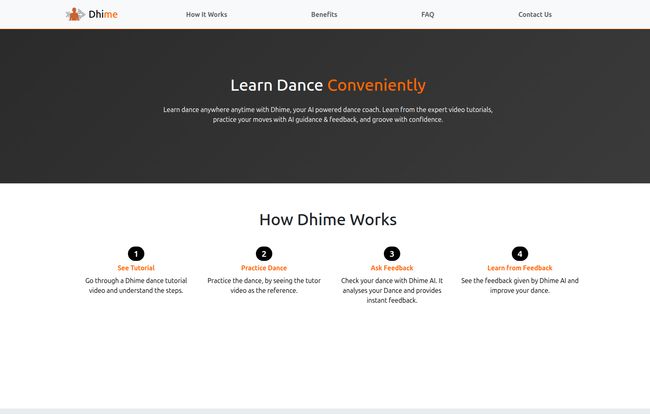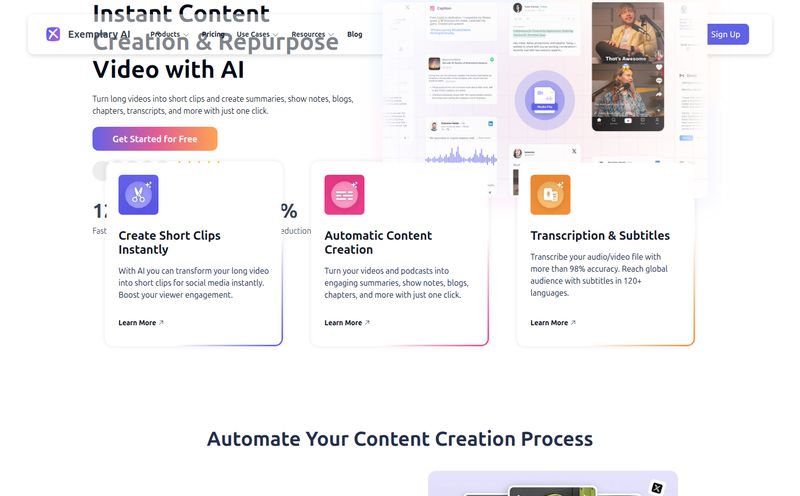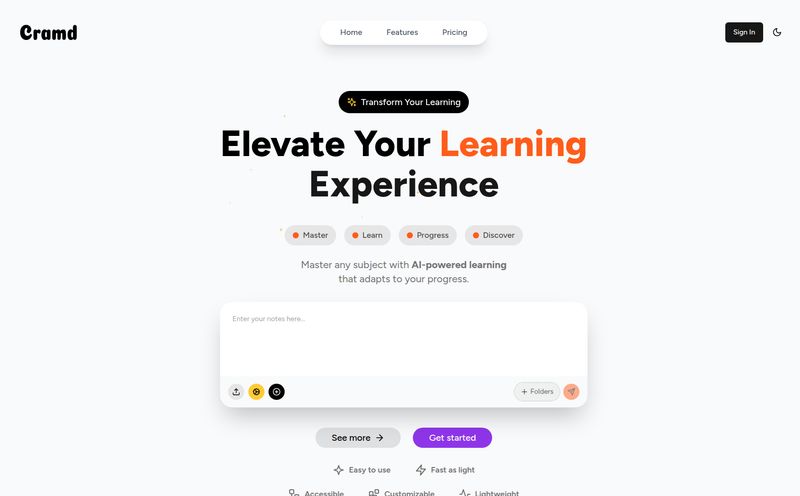Look, I get it. The thought of dancing in a class, surrounded by mirrors and people who somehow already know what a plié is, can be... terrifying. For years, the only options were to brave a studio, awkwardly follow a YouTube video in your living room hoping the cat doesn't judge you, or just give up and stick to the classic head-nod at parties. It's a tough spot for anyone with two left feet and a desire to learn.
But the world of tech is getting weird and wonderful, and AI is creeping into every corner of our lives. So, it was only a matter of time before it came for the dance floor. I recently stumbled upon a platform called Dhime, which bills itself as an AI-powered dance coach. An AI. For dancing. My curiosity was officially piqued. Could a robot really teach me how to groove without the anxiety of a live audience? Let's find out.
What on Earth is Dhime, Exactly?
At its core, Dhime is an online platform designed to teach you how to dance from literally anywhere. The big twist? It uses Artificial Intelligence to watch you and give you feedback. No, it’s not some dystopian robot staring at you. It’s an app on your phone or a tool in your browser that uses your device's camera to analyze your movements and compare them to the instructor's in the tutorial video.
Think of it like a spell-checker for your dance moves. You watch an expert, you try to copy them, and the AI gently nudges you, saying, “Hey, your arm was a little low there,” or “Try making that step a bit sharper.” It’s a private, on-demand dance tutor that doesn’t get tired or impatient. You just need a device with a camera and some space to move around.

Visit Dhime
How Does This AI Magic Actually Work?
The process is surprisingly straightforward, which is something I always appreciate. There are no complicated setups or tech hurdles. It’s broken down into a simple four-step loop:
- Watch the Tutorial: First, you pick a lesson and watch an expert instructor break down the moves. Simple enough.
- Time to Practice: Now it’s your turn. You practice the choreography with the tutorial video playing as your guide. This is your moment to shine (or flail) in complete privacy.
- Ask the AI for Feedback: Once you feel like you've got a handle on it, you hit a button to have Dhime’s AI analyze your performance. You do the routine, and the AI 'watches' you through your camera.
- Learn and Improve: A moment later, you get a report. The AI provides instant, specific feedback on your form, timing, and posture. You see what you nailed and where you need to polish things up, then you can jump right back into practice.
It’s a continuous feedback loop that, in theory, should lead to much faster improvement than just blindly copying a YouTube video. Its genius, really.
The Good Stuff: Why Dhime Might Be Your New Best Friend
So, what’s the big draw? Based on my analysis and what the platform promises, the advantages are pretty compelling, especially for a certain type of learner.
The Ultimate Convenience Factor
This is the most obvious win. There’s no fixed schedule. No commuting to a studio after a long day of work. You can learn to dance at 2 PM on a Tuesday or 2 AM on a Saturday. Your living room becomes your dance studio. For anyone with a chaotic schedule or a healthy dose of social anxiety, this is a game-changer. Plus, the privacy aspect is huge. You can mess up a hundred times, and no one will ever know. The freedom to practice without fear of judgment is a massive barrier removed.
Actually Getting Better with AI Feedback
Here’s where Dhime separates itself from just watching videos online. The AI guide is always available, offering unlimited practice and continuous progress tracking. Because the feedback is immediate, you’re not practicing your mistakes over and over. The lessons can also be tuned to your individual style and pace. It’s a personalized learning path that's hard to replicate without a private, and expensive, human tutor.
Let's Be Real: The Not-So-Perfect Parts
Alright, it can't all be perfect, right? No platform is. As an SEO who’s seen a million 'revolutionary' tools, I’ve learned to be a healthy skeptic. Here are a few things to keep in mind.
The most significant point is the lack of direct, human interaction with a tutor. An AI can correct your form, but it can’t explain the feeling or the emotion behind a movement. It can't answer a creative question or give you that spark of encouragement that a great teacher can. For some, this is a deal-breaker.
Also, it’s all dependent on the technology. You need a device with a decent camera, and your progress is tied to the accuracy of the AI’s feedback. While AI has come a long way, it’s not infallible. Will it be able to distinguish between a stylistic choice and a mistake? That remains a key question.
Who is Dhime Really For?
After looking through its features, Dhime seems to have a few key audiences in mind.
For the Shy Beginner or Hobbyist
This is the sweet spot. If you've always wanted to learn but felt too intimidated, this is your sandbox. It provides a safe space to build a foundation of skills and confidence before you ever step into a real class—if you even want to.
A Tool for Tutors and Dance Studios
This was an interesting angle I saw on their site. Dhime isn't just for individuals. It’s also positioned as a tool for dance academies and tutors. Instructors can have their students use Dhime for home practice, ensuring they’re following the class syllabus correctly between sessions. It’s a smart way to add value and offer a competitive edge. It helps tutors identify dedicated students and gives them a way to reach a global audience.
Dhime vs. The Old Guard: YouTube and Zoom Classes
This is the real showdown. How does it stack up against the alternatives? I’d say it fills a very specific gap between the two.
YouTube is a massive, free library. But it's a one-way street. You watch, you copy, you hope for the best. There's no feedback mechanism, which means you can practice a move incorrectly for weeks without realizing it. It's like reading a cookbook with no one to taste your food.
Zoom classes brought the instructor into our homes, which was a huge step up. You get real-time human feedback. However, in a group class, an instructor's attention is divided. They might catch a few of your mistakes, but they can't focus solely on you for an entire hour. Its also on a fixed schedule.
Dhime sits in the middle. It offers the on-demand convenience of YouTube but adds the critical feedback loop that YouTube lacks. It provides more focused, consistent technical correction than you might get in a crowded Zoom class. It's not a replacement for a human, but it's a powerful supplement.
What About the Price Tag?
Here's the million-dollar question. I went looking for a pricing page to see what this would set you back, but the link seems to be down at the moment—I just hit a 404 error page. So, for now, the cost of Dhime is a bit of a mystery. They don't have public pricing listed on the main site. My guess is they might have a subscription model, maybe with different tiers. Your best bet is to check out their site and use their contact form to ask directly.
Frequently Asked Questions About Dhime
I noticed a few common questions on their site that are worth addressing directly.
Can a total beginner learn to dance with Dhime?
Absolutely. In fact, this seems to be one of the primary use cases. The private environment and instant feedback are ideal for someone starting from scratch.
Is the AI replacing human dance tutors?
I don't think so. The creators themselves seem to position it as a tool and a practice aid, not a replacement. An AI can teach you the 'what' (the steps) but a human teacher excels at the 'how' and 'why' (the artistry, emotion, and context).
How is this different from learning on YouTube?
The key difference is the feedback loop. YouTube is passive watching; Dhime is active learning with AI-driven correction to improve your form.
Is the app recording me? What about privacy?
This is a valid concern for any app using a camera. While their FAQ addresses this, you'd want to read their privacy policy carefully. Typically, platforms like this process the video feed for analysis without storing the raw footage long-term, but it's always good to confirm.
Final Thoughts: Should You Give Dhime a Whirl?
So, what’s the final verdict? I'm genuinely intrigued. Dhime isn't going to turn you into a prima ballerina overnight, and it won’t replace the magic of a passionate, in-person instructor. But that’s not its goal.
Its a powerful, modern tool that solves a very real problem: the barrier to entry for learning to dance. It makes practice more effective, more convenient, and far less intimidating. For the self-conscious beginner, the busy hobbyist, or the dedicated student looking to perfect their technique between classes, Dhime could be an incredible asset. It’s a sign of where learning is headed—more personalized, more accessible, and a whole lot smarter.
If you've been on the fence about learning to dance, this might just be the push you need to finally take that first step. In the privacy of your own home, of course.
Reference and Sources
- The official Dhime website: https://dhime.in/



